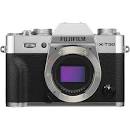Comparison of the FUJIFILM X-T30 with the FUJIFILM X-T20 and X-T3
The strategy of creating a functionally saturated camera and its further simplification and adaptation for amateur photographers has been repeatedly demonstrated by Fujifilm. The pair of cameras FUJIFILM X-T3 and X-T30 was no exception. However, the youngest product - FUJIFILM X-T30 - has turned out so advanced and powerful that it clearly claims to be the market leader in “cropped” cameras for enthusiasts. Is the X-T30 so awesome in reality, or are there pitfalls between spec lines? About it in our big test! Get price FUJIFILM X-T30 We will start traditionally with a table of characteristics and its analysis. I suggest looking at the specifications of the previous FUJIFILM X-T20 model to understand the performance boost in the X-T30; and also compare them with the older X-T3 - the immediate progenitor of the hero of our test. This will allow us to evaluate how much simplifications were made when adapting the camera for a more accessible market segment.X-T30 / XF55-200mmF3.5-4.8 R LM OIS Installations: ISO 160, F8, 1/300 s, 300.0 mm equiv.Download RAW
Feature Comparison of the FUJIFILM X-T20, X-T3 and X-T30
| FUJIFILM X-T20 | FUJIFILM X-T3 | FUJIFILM X-T30 | |
| Bayonet mount | FUJIFILM X-Mount | FUJIFILM X-Mount | FUJIFILM X-Mount |
| Matrix | 24.3 MP, APS-C, X-Trans CMOS III | 26.1, APS-C, X-Trans CMOS 4 | 26.1, APS-C, X-Trans CMOS 4 |
| Maximum photo resolution | 6000 × 4000 | 6240 × 4160 | 6240 × 4160 |
| Photosensitivity | ISO 200–12800 expandable to ISO 100/25600/51200 | ISO 160–12800 expandable to ISO 80/100/125/25600/51200 | ISO 160–12800 expandable to ISO 80/100/125/25600/51200 |
| Shutter speed range | Mechanical shutter 30–1 / 4000 s; mechanical + electronic 30–1 / 32000 s | Mechanical shutter 30–1 / 8000 s; mechanical + electronic 30–1 / 32000 s | Mechanical shutter 30–1 / 4000 s; mechanical + electronic 30–1 / 32000 s |
| Sync speed | 1/180 s | 1/250 s | 1/180 s |
| Burst shooting | Up to 14 frames / s, up to 8 frames with a mechanical shutter | Up to 30 frames / s with crop x1.25, up to 20 frames / s without crop, up to 11 frames with a mechanical shutter | Up to 30 frames / sec with crop x1.25, up to 20 frames / sec without crop, up to 8 frames / sec with mechanical shutter |
| Buffer capacity for high-speed shooting | Up to 23 RAW | Up to 35 RAW | Up to 17 RAW |
| Focusing | Hybrid AF (TTL contrast AF / TTL phase AF) | Hybrid AF (TTL Contrast AF / TTL Phase AF) over the entire area of ??the frame | Hybrid AF (TTL Contrast AF / TTL Phase AF) over the entire area of ??the frame |
| Maximum movie resolution | Up to 3840x2160 at 30 frames / s (up to 10 minutes) | Up to 4096 × 2160 at 60 frames / s (up to 20 minutes) | Up to 4096 × 2160 at 30 frames / s (up to 10 minutes) |
| Maximum bitrate | 100 Mbps | 400 Mbps | 200 Mbps |
| F-Log Support | Not | there is | there is |
| Screen | Touch, tilt, 3-inch 1.04 million dots | Touch, swivel, 3-inch 1.04 million dots | Touch, tilt, 3-inch 1.04 million dots |
| Viewfinder | OLED 2.36 million points | OLED 3.69 million points | OLED 2.36 million points |
| Wireless interfaces | Wifi | Wi-Fi and Bluetooth | Wi-Fi and Bluetooth |
| Memory cards | SD UHS-I | SD UHS-II | SD UHS-I |
| Interfaces | USB 2.0, micro-HDMI, 2.5 mm microphone | USB Type-C, micro-HDMI, 3.5 mm microphone, 3.5 mm headphone, sync | USB Type-C, micro-HDMI, 2.5 mm microphone |
| Battery and life (by CIPA) | NP-W126S, up to 350 frames | NP-W126S, up to 390 frames | NP-W126S, up to 380 frames |
| Working temperature | 0 ° C to 40 ° C | -10 to 40 ° C | 0 ° C to 40 ° C |
| Working humidity | 10–80% (non-condensing) | 10–80% (non-condensing) | 10–80% (non-condensing) |
| Dimensions | 118.4 mm (W) × 82.8 mm (H) × 41.4 mm (T) | 132.5 mm (W) × 92.8 mm (H) × 58.8 mm (D) | 118.4 mm (W) × 82.8 mm (H) × 46.8 mm (T) |
| Weight with battery and memory card | 383 g | 539 g | 383 g |
FUJIFILM X-T30 comes in three colors
FUJIFILM X-T30 with lens XC15-45MMF3.5-5.6 OIS PZ
FUJIFILM X-T30 with XF 18-55MM F2.8-4 R LM OIS lens


